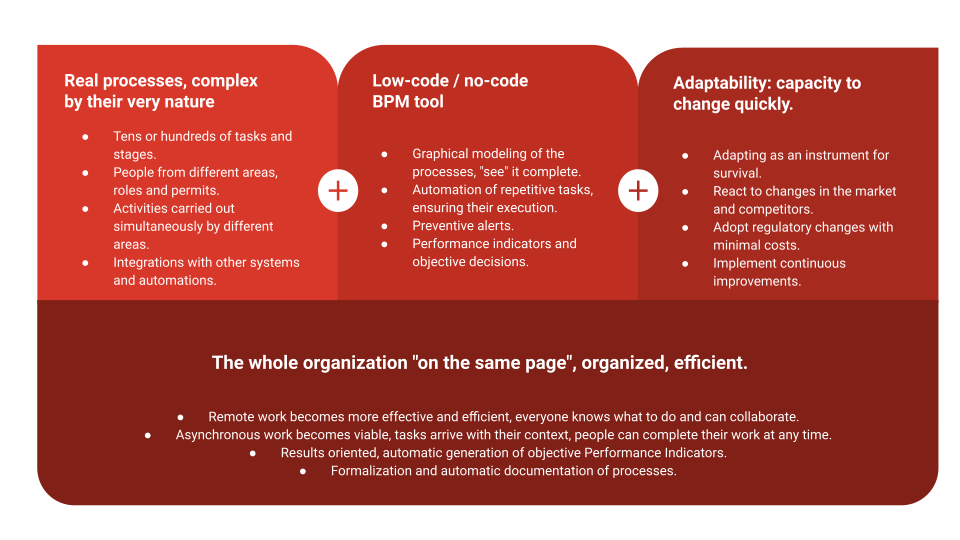Real and complex processes? Better that way!
Blog: Flokzu
Many times it happens that the real processes of our organizations are complex. And it’s okay that they are, given the nature of the issues those processes solve. Automating these processes requires a BPM tool that is user-friendly yet powerful.
In the last several years, low-code / no-code BPM tools have gained great importance, mainly for allowing business users to build their own applications. In this way, organizations have more agility for delivering business solutions, and at the same time, reduce the dependency on the IT departments that are always overloaded.
However, some low-code / no-code tools, in their eagerness to be very simple and easy to use, fail to support more complex realities and processes. And as in real life, many of our processes are very complex, and choosing the right tool for my organization becomes a key point.
In this post, we demystify that complex processes are a bad thing. On the contrary, they are necessary. Automating them well can lead our organization to a well-balanced state of operation, with aligned and productive collaborators.
Processes, tools, adaptation.
In the following illustration we summarize the approach we will take on the subject, with three main topics (complex processes, business process management tools, adaptability requirements) and a result (an organized and efficient organization):

Real complex processes.
Certainly, processes can get complex. In the following illustration we present an example of a part of a process that might perfectly be of your organization.

Of course, we must avoid errors when modeling a process, especially when we use parallelisms. In this post, we describe good practices when using these instruments.
The important thing is to understand that a process that has dozens or hundreds of tasks and stages is perfectly normal. And because of this, it will have dozens of users too, that could work simultaneously or sequentially, synchronously or asynchronously. And, of course, there may be integrations with other systems through web services.
All of this is completely normal. Sure, the attentive reader will think, how can I handle all of that without a specific process tool? How can I manage a process of that complexity with spreadsheets and emails? Well… it’s impossible!
And there, the second key element comes into the game…
A low-code / no-code BPM tool
A Business Process Management Suite will allow us to model the process completely. And in doing so, it will allow us to “see” it. Discover all the tasks that compose it, eventually eliminate those that do not add value, and discuss with the person in charge if it is indeed the best way to operate.
Also, the BPM Suite will allow us to automate repetitive tasks. We can define alerts and timers that automatically send a reminder to avoid delays.
Furthermore, a serious BPM will generate Key Performance Indicators (KPI’s) to measure how the processes are performing in real-time and historically. From these KPI’s, we will be able to make decisions based on objective data and not on perceptions.
Adaptability: a survival condition
Organizations, especially private ones, that survive and grow are those that adapt best to their environment.
Reacting in time to competitors and market changes is key. Doing so late can lead directly to losing market share and face extinction in its most serious state.
Similarly, adopting normative changes is unavoidable. The organizations that make a difference are the ones that can adopt them at the lowest cost, thus generating a relevant competitive advantage.
The ability to model processes and deploy them in production without programming and complex configurations is the spirit of Low-Code / No-Code tools. And it is the main ingredient to achieve adaptability, fast and low cost.
Everyone in the same page
By adding the three previous components (real processes, BPM tool, and adaptability), we will achieve the desired result: having the entire organization on the same page, operating in an orderly and efficient manner. And we will achieve this precisely because it has complex processes. If you didn’t have them, there would be no point in using a process management tool!
Having the processes formalized and digitized, we will facilitate effective and efficient remote work. Everyone knows what to do. The process is well defined, and we do not depend on everyone knowing what the next task is. That knowledge was formalized in the process model and is now an asset of the organization.
Working asynchronously, anytime, anywhere is possible, as tasks “arrive” to people, including the context needed to complete them. This includes the relevant data, necessary attachments, possible decisions, and also the business rules that apply at each stage of the workflow.
Conclusions
Complex processes are part of our organizations. Trying to automate them with overly simple, under-powered tools is a serious mistake that can derail the process improvement initiative.
It is very important to use a low-code / no-code tool to see quick results and achieve future adaptability. But the tool we choose must be powerful enough to support processes with hundreds of tasks, users, parallelism, and integration with other systems. With Flokzu, thousands of customers around the world have implemented highly complex processes in short periods.
Once we automate complex processes, we will obtain enormous benefits. The organization will operate much more orderly and efficiently and will also be able to respond to changes, a fundamental requirement to survive and grow.
The post Real and complex processes? Better that way! appeared first on Flokzu | Cloud BPM & Cloud Workflow.
Leave a Comment
You must be logged in to post a comment.








